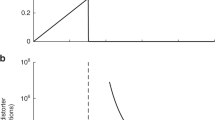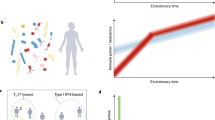Abstract
INDIVIDUAL, animals of a given species show well-defined, genetically controlled differences in the composition of certain isofunctional proteins. This molecular polymorphism is essentially of two types. The first type is one in which an isofunctional protein such as haemoglobin is present in all individuals of the species and the individuals differ from one another by the amino-acid sequence in limited regions of the molecule. The second type of polymorphism is characterized by the presence or absence of a particular protein in different animals of the same species. We wish to propose here a general nomenclature for these two polymorphic states.
This is a preview of subscription content, access via your institution
Access options
Subscribe to this journal
Receive 51 print issues and online access
$199.00 per year
only $3.90 per issue
Buy this article
- Purchase on Springer Link
- Instant access to full article PDF
Prices may be subject to local taxes which are calculated during checkout
Similar content being viewed by others
References
Oudin, J., C.R. Acad. Sci., Paris, 242, 2606 (1956).
Medawar, P., Nature, 207, 1327 (1965).
Cinader, B., Dubiski, S., and Wardlaw, A. C., J. Exp. Med., 120, 897 (1964).
Cinader, B., and Dubiski, S., Nature, 202, 102 (1964).
Cinader, B., Nature, 188, 619 (1960).
Cinader, B., and Dubiski, S., in La Tolérance acquise et la Tolérance Naturelle a l'Égard de Substances Antigéniques Définies, Royamount 25–28juin 1962 , edit. by Bussard, A., 255 (Centre National de la Recherche Scientifique, Paris, 1963).
Biggs, R., and Macfarlane, R. G., Human Blood Coagulation and its Disorders, third ed. (Blackwell Scientific Publications, Oxford, 1962).
Stefanini, M., and Dameshek, W., Hemorrhagic Disorders, second ed. (Grune and Stratton, New York, 1962).
Harris, H., Human Biochemical Genetics (Cambridge Univ. Press, London, 1959).
Hsia, D. Y., Inborn Errors of Metabolism (Year Book Publishers, Chicago. 1959).
Aebi, H., Heiniger, J. P., Bütler, R., and Hässig, A., Experientia, 17, 466 (1961).
Takahara, S., Lancet, ii, 1101 (1952).
Harris, H., in Second Intern. Conf. Congenital Malformations, New York City, July 14–19, 1963 , edit. by International Medical Congress, Ltd., 135 (International Medical Congress, Ltd., New York, 1964).
Author information
Authors and Affiliations
Rights and permissions
About this article
Cite this article
CINADER, B., DUBISKI, S. & WARDLAW, A. Allotypy and Eniotypy. Nature 210, 1291–1292 (1966). https://doi.org/10.1038/2101291b0
Issue Date:
DOI: https://doi.org/10.1038/2101291b0
Comments
By submitting a comment you agree to abide by our Terms and Community Guidelines. If you find something abusive or that does not comply with our terms or guidelines please flag it as inappropriate.



